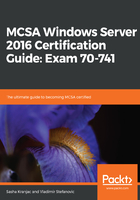
上QQ阅读APP看书,第一时间看更新
The autoconfiguration process
An address autoconfiguration for an IPv6 host is performed and described in the following steps:
- A host sends a Router Solicitation message.
- If a host receives a Router Solicitation message, then it is configured using the information obtained in this message.
- If a host does not receive a Router Solicitation message, then it can use the address configuration protocol (DHCPv6) to configure itself with the address and other configuration parameters.
- The stateless address prefix and the 64-bit address identifier are both used to obtain a tentative address. The existence of a duplicate tentative address is verified during the process. If an address is not a duplicate, and, therefore, not in use, the address is initialized and a host obtains valid and preferred lifetimes in the Router Advertisement message.
Similar to DHCP for the configuration of IPv4 addresses, DHCPv6 also uses UDP messages, which DHCPv6 servers and relay agents listen for on UDP port 547. Unlike DHCP for IPv4, DHCPv6 has no broadcast addresses or messages.
The list of valid DHCPv6 messages and their comparison to DHCP IPV4 messages is shown in the following table:
